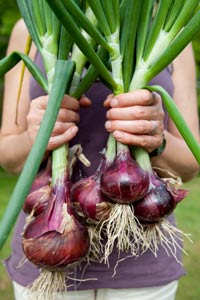
Have you heard the phrase "orchids and onions?" It seems to be a way of classifying the good and the bad. For orchid fans like us, it is fairly obvious that saying something is an orchid is a *good* thing--beautiful, blooming, generally positive. But an onion could really go either way—though it gives off a strong odor, it's also essential to adding flavor to delicious dishes.
Looking for clarification, we found an architectural organization called Orchids and Onions whose objective is to inspire excellence by nominating "what makes your heart soar, or what's just a plain eyesore." We can all agree that orchids make our hearts soar, and that onions cause our eyes to become irritated and watery.
What confused us once again was their column called "Blooms and Bulbs." Blooms are good, but bulbs indicate that there is potential for a bloom, despite the less attractive package. Here's the flower science behind that: some epiphytic orchids from the family Orchidaceae form above-ground storage organs called pseudobulbs that superficially resemble bulbs. All plants that form true bulbs are monocotyledons, and include:
But a website about phrases finally cleared it up for us. They gave us other similar sayings that indicate approval and disapproval:
But the combination brings to mind a classy restaurant that combines the beauty of orchids with the flavors of the onions—all good.

Copyright Just Add Ice® Orchids 2023